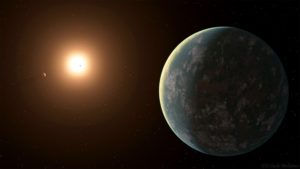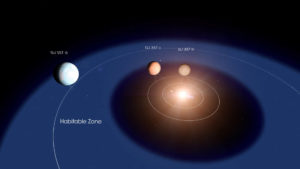TESS’s First Year of Science – Sky & Telescope
NASA’s latest exoplanet hunter has found more than two dozen new worlds, at least one of which might be habitable.
The prospect of finding an Earth-like exoplanet has long fueled the imagination of scientists and laypeople alike. Now NASA’s latest planet-hunting mission, the Transiting Exoplanet Survey Satellite (TESS), might just rustle up such a world.
This past week, nearly 300 planet hunters and assorted scientists congregated in Cambridge, Massachusetts, to share their findings at the first conference dedicated to the science emerging from the TESS mission since the spacecraft’s launch in April 2018.

This artist’s illustration shows what the GJ 357 system might look like.
Jack Madden / Cornell University
TESS Science Conference I coincides with the start of the mission’s second year of science operations. A couple of weeks ago, TESS flipped from observing the celestial southern hemisphere to the northern one, and during the conference week has pointed at the Kepler mission’s original star field.
TESS’s goal is to find planets around bright stars within 200 light-years of Earth. The spacecraft’s unique 13.7-day lunar resonant orbit takes it along a highly elongated path that loops nearly as far away from Earth as the Moon does. In this orbit, few disturbing forces act on the satellite, allowing the instruments to operate stably, principal investigator George Ricker (MIT) explained in the conference’s opening session.
The spacecraft’s mode of operation divides the sky into 26 sectors, long strips that extend from each pole to near the ecliptic. It completed its scans of all 13 sectors in the southern hemisphere during the first year of operations. TESS TOI (TESS Object of Interest) manager Natalia Guerrero (MIT) brought the audience up to date with the current status of cataloging and identifying TESS objects: Thus far, TESS has identified 993 planet candidates in the 12 southern sectors (the 13th sector is currently being analyzed), of which 271 are smaller than Neptune. These numbers were updated during the week when the announcement of two newly identified systems, TOI 270 and GJ 357, rippled through the attendees, bringing the number of confirmed TESS exoplanets to 28.
Both of the new systems, anchored by small, M dwarf stars, are thought to host three exoplanets each. Lisa Kaltenegger (Cornell) is particularly excited about GJ 357, located at a distance of 31 light-years. Astronomers found the innermost world with TESS, and then discovered the other two with ground-based observations of the star’s wobble in response to its orbiting exoplanets. The outermost planet, GJ 357d, is a super-Earth weighing in at about 6 Earth masses that most likely orbits in the star’s habitable zone — the place where, if the world is rocky and has an Earth-like atmosphere, liquid water could exist on its surface.

The outermost planet of the GJ 357 system orbits within the habitable zone. If it has a dense enough atmosphere and a surface, liquid water may exist there.
NASA’s Goddard Space Flight Center / Chris Smith
What excites Kaltenegger and her team is that this planet should be relatively bright. “Bright means we get enough light to split it up into colors, and this will tell us about the composition of its atmosphere,” she says. It’s therefore one of the best targets to date for follow-up observations with more powerful telescopes, such as the James Webb Space Telescope or the Extremely Large Telescope, which may reveal whether the exoplanet has an atmosphere or not — and if it does, what that atmosphere is composed of. “I like our chances,” Kaltenegger concludes.
Even More Science with TESS
TESS can do more than search for exoplanets, as numerous talks and a plethora of posters informed. TESS can detect many kinds of transient events, such as luminous supernovae. It’s also finding asteroids and detecting exocomets, as it did around Beta Pictoris, confirming earlier spectroscopic and photometric comet detections.
TESS is also discovering other transiting bodies, such as brown dwarfs. Roughly the size of the most massive gas giants, these objects are often considered to be “failed” stars. The very first brown dwarf discovered by TESS is TOI-503 and is currently being analyzed in depth by a group led by astronomers in the Czech Republic. PhD student Ján Šubjak (Astronomical Institute of the Czech Academy of Sciences) presented the ongoing work in a poster session. (Incidentally, the work brought with it another first: Šubjak’s visit to Massachusetts gave him his first glimpse of the ocean.)
The TESS mission has been extended through 2022, with options to go beyond. During the next year the team will complete the northern hemisphere map, and then move onto the extended phase, after which the sky covered by TESS will be 94%. The extended mission is expected to bring in results on long-period planets and identify more habitable-zone planets and multiple-planet systems, among other goals. TESS scientists already collaborate with an extensive network of ground-based astronomers for follow-up studies, and Ricker is looking forward to expanding that network and overlap with current and upcoming missions, such as CHEOPS and JWST. We might be very close indeed to identifying an Earth analog.






